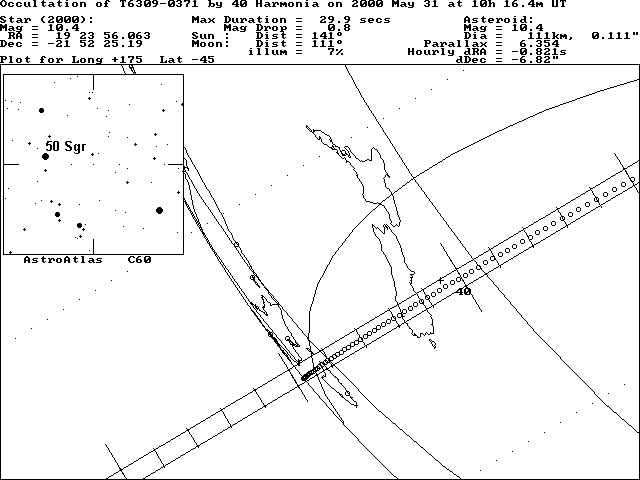ASTROMETRIC UPDATE:
OCCULTATION BY (40) HARMONIA - 2000 MAY 31
CHECK THIS PAGE REGULARLY FOR FURTHER UPDATES AND CHANGES TO THE TRACK.
YOU MUST RELOAD THIS PAGE USING YOUR BROWSER'S
RELOAD/REFRESH BUTTON TO OBTAIN UPDATES!
[Prediction by Edwin Goffin]
[Prediction using OCCULT software]
[Detailed finder chart by Jan Manek]
Goffin's path crosses the western portions of the Amazon basin and central Peru. After crossing the southern Pacific Ocean, the path crosses the central parts of the South Island of New Zealand. The path given by OCCULT lies around 1 path width to the south and 100 seconds later crossing the South Island around the Oamaru/Dunedin area and clipping the north-east corner of Tasmania at very low altitude.
UPDATE: 27 May 2000
This prediction update has been computed by Jan Manek of the Stefanik Observatory based on astrometry from Ron Stone of the US Navel Observatory - Flagstaff Station, Bill Owen of TMO and the Hipparcos astrometric mission. The Tycho-2 position of the target star has been used.
Summary:
This update indicates a shift to south of around 1 path width and around 0.6 of a minute later than that given by Goffin. In New Zealand, the path crosses the South Island in the Oamaru/Dunedin area (10:41:15 UT - Altitude = 29 degrees). The path then runs on to clip the very north-eastern portions of Tasmania at very low altitude (10:44 UT - Altitude = 12 degrees).
Particular attention is drawn to the very low magnitude drop involved in this event (only around 0.8). There is a slightly fainter star (TYC 6309 564) around 35" to north east and noted on the attached finder chart. Observers can carefully compare the brightness of the two stars to detect the event. The asteroid should be plainly visible.
Also of note is the fact that the asteroid is moving quite slowly at this time resulting in a long predicted duration. For this reason, observers are requested to monitor this event for as long as possible (up to 30 minutes) around the predicted time for their location.
THE EVENT AT A GLANCE:
- Date and approx. UT time of event: May 31, 2000 @ 10:41 UT
- Magnitude of target star: 10.4
- Magnitude drop [mag]: 0.8 !!
- Estimated maximum duration [s]: 29.9
- Path description: See above.
- Goffin's original chart reference: A00_0506
The Occultation Path:
- Approximate width [km]: 115
- Uncertainty [path widths]: 1.0
- Uncertainty in time [s]: 30
- Map: See below
- Remarks: Uncertainities are given on the basis of the nominal star position errors and the expected asteroid positional accuracy.
- Circles along the path are OCCULT calculated exact centerline points !!!!
Data for the target star:
- Name: TYC 6309-00371-1
- Constellation: Sagittarius
- J2000 position [h,m,s; o,',"]: 19h 23m 56.063s; -21o 52' 25.19"
- Position source: Tycho 2
- Estimated accuracy ["]: 0.07" (0.05", 0.06")
- V mag [mag]: 10.36
- B-V [mag]: +0.60
- Remarks:
- The target star is in north-eastern Sagittarius, 3.4 degrees east of pi Sgr (magnitude = 2.9) and 33' west of 50 Sgr (magnitude 5.6). As noted earlier, there is a magnitude 11.2 star (TYC 6309-0064-1) 35" east of the target star.
To see a detailed finder chart, click here.
Data for the minor planet:
- Number, name: (40) Harmonia
- Approx. diameter [km]: 111
- Source of used astrometry: US Navel Observatory - Flagstaff Station (Ron Stone), TMO (Bill Owen), Hipparcos
- Number of used observations: 38 USNO, 12 TMO, 113 Hipparcos
- Number of rejected observations: 2 USNO, 1 TMO, 1 Hipparcos
- Time covered by the observations: 1990 03 18 - 2000 05 19
- RMS residuals ["] (RA,DE): 0.05", 0.05"
- Estimated positional accuracy at epoch of event ["]: 0.05"
Data for the event:
- UT date and time of least geocentric approach: 2000 May 31, 10:16.4 UT
- Approx. V mag of minor planet at event [mag]: 10.4
- Geocentric parallax of minor planet ["]: 6.345
- Magnitude drop [mag]: 0.8
- Estimated maximum duration [s]: 29.9
- Apparent motion of minor planet ["/h]: 13.29
- Angular distance to moon, phase of moon [deg,%]: 111, 7%
- Update computed by: Jan Manek - Stefanik Observatory - Prague, Czech Republic.

IMPORTANT NOTE!
Astrometric updates such as these should not be taken as definitive, but rather only as an indication of where the true track may lie relative to the original predicted track. Observers must bear in mind that later astrometry, in which the target star is measured in the same field as the asteroid, may still reveal substantial changes to the predicted track and time of the event. For this reason it is most important that observers far from the predicted track still monitor the event.
Use these links for further information:
[Planetary Occultations]
[Using the Predictions]
[Observing Details]
[Timing Details]
[Reporting Details]
[Report Form]
[Asteroid Occultation Results]
This page may have been updated since 27 May 2000.
Hit your browser's RELOAD button to get the latest version.
[Site Map]
[What's an Occultation?]
[Total Occultations]
[Grazing Occultations]
[Planetary Occultations]
[Jovian Satellite Eclipses]
[Timing Occultations]
[Reporting Observations]
[Coming Events]
[Software]
[About Us]
[Publications]
[Membership]
[Links]
[Top of Page][Return to Home Page]
